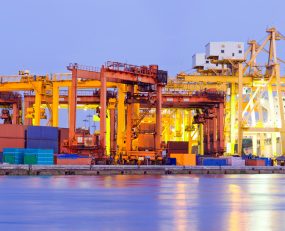
With net-zero carbon emission targets in mind, massive investment is being made in alternatives to fossil fuels. Although renewables, such as wind and solar, will play an important role in powering future needs, their inherent unreliability and seasonality will require complementary balancing of needs through additional fuel sources. If conventional dirty coal, oil and gas are ruled out, this leaves the options (at present) of nuclear and hydrogen.
It is the latter that is being regarded by ports around the world as offering the most potential. For hydrogen to be ‘green’ it needs to be generated using non-fossil fuels. Unsurprisingly, countries in the Middle East are investing heavily in solar arrays and hydrogen plants as a way of mitigating the risk of falling demand for their oil. The climate in the region makes this transition from fossil fuels very achievable. Interestingly, Iceland is also promoting its ability to leverage its geothermal resources to generate hydrogen.
Wherever it is produced – whether from solar, wind, wave, nuclear or geothermal, the gas has to be liquefied and then transported to end markets in super-insulated gas tankers. As is the case for chemicals, oil and natural gas, this will mean that main ports around the world will not only be gateways but also hubs for the distribution of hydrogen.
The focus of ports on hydrogen is not just seen as an opportunity, but as a necessity in order to replace the revenue accruing from storage and distribution of fossil fuels once these resources are eventually phased out. However, due to the close proximity of many ports to off-shore wind farms, they can also provide a location for hydrogen generation themselves. Existing downstream pipelines will eventually mean that these can be converted to carrying hydrogen rather than natural gas. Ports often also host heavy industry manufacturing facilities (e.g. chemical and steel) due to the ease with which they can access imports of raw materials and this would equally apply to hydrogen, used both as an energy carrier and a feedstock.
In many ways, the new investment in hydrogen infrastructure at ports will replace existing fossil fuel facilities which will be gradually wound down in line with government climate change policies (in theory at least). However, it will mean that new relationships will be developed, such as that recently announced between the Port of Rotterdam and Landsvirkjun, the National Power Company of Iceland; changing upstream supply chains and presenting opportunities for new investment across a port’s real estate. In terms of downstream supply, ports will also be keen to ensure that they are connected to the pipelines which take the hydrogen to key industrial areas within their hinterlands.
There is also the question of bunkering for the shipping industry. Trials are presently underway to determine the feasibility of using hydrogen as an alternative for heavy fuel oil. Many shipping lines prefer the option of Liquified Natural Gas (LNG), but this could only be a stop-gap solution to total decarbonization. Shell is working with Singapore’s SembCorp Marine and the Port Authority to establish the viability of this ‘frontier fuel’ in shipping. If hydrogen is indeed adopted, ports would, over the next three decades, need to achieve a shift from established bunkering systems. This would be very complex and expensive, especially for minor ports in developing economies. How this would be achieved is yet to be seen.
Source: Transport Intelligence, June 17, 2021
Author: John Manners-Bell